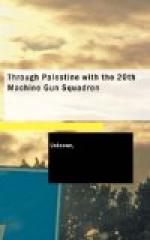[Illustration]
Several ladies graced a concert given in the Squadron camp, being conducted there by certain gallants in two “G.S.” wagons and “fours-in-hand”! Another diversion to the monotony here, was a trip to Jerusalem, which was well worth the tiring journey, although many were disappointed in the “side-show-at-an-exhibition” effect, which many of the most sacred spots presented. It was, however, gratifying to think, that this, the home of our religion, for which the Crusaders had fought and died, was at last rescued from the hands of the infidel. Ten days’ leave was granted to Cairo, Port Said and Alexandria, but “turns” were necessarily very slow in coming round.
WE MOVE TO SARONA.
The month of May heralded another “move,” and at 09.00 on the 4th, the Brigade concentrated at the north end of Belah lake and set off northwards. Nights being spent, successively, three miles north-east of Gaza; two miles north-east of El Mejdel; one mile east of Wadi Sukereir (heavy downpour of rain on this day). On the 7th the trail led along the edge of the sand-dunes and through Yebna[11] to Wadi Hanen. Here a halt of two hours was made, to water and feed. The country was very picturesque, being thickly planted with orange-groves, whilst here and there a red-tiled building was to be seen. At 13.00 the march was continued through Rishon-le-Zion to the main Jaffa-Ramleh road which is a thoroughly good metal one. Along this a few miles, thence north to Sarona, two miles north-east of Jaffa.
Arriving at Sarona at 16.30, the Squadron encamped beside an orange-grove and adjoining the Aerodrome. It may here be mentioned that Sarona before the war was a German colony, and from its appearance, must have been a prosperous one. The main street is lined on both sides with detached and semi-detached houses, mostly with red tiles, prettily designed. Fir trees are abundant and help to make a pleasing picture. Outside the village there are many orange-groves and vineyards, each with its red-tiled house, which has, either inside or in a separate building, a well with an engine for pumping water into a stone cistern, from which it is allowed to run, as required, along concrete gullies, and thus distributed over the land, irrigating it.
In consequence of the camp proving insanitary the morning after arrival, the Squadron moved about half a mile nearer the coast into a vineyard! This was an exceedingly pretty spot, from which an excellent view of Jaffa could be obtained; a few trees provided us with the unaccustomed luxury of some shade. The Brigade was attached to the 21st Infantry Corps and was “Corps Reserve”. A training-area was allotted, and every morning the Squadron went out for mounted training through the village across the narrow gauge “Heath Robinson” railway, and through the orange-groves out to the area beyond Point 275 and north of the Village of Selmeh.




